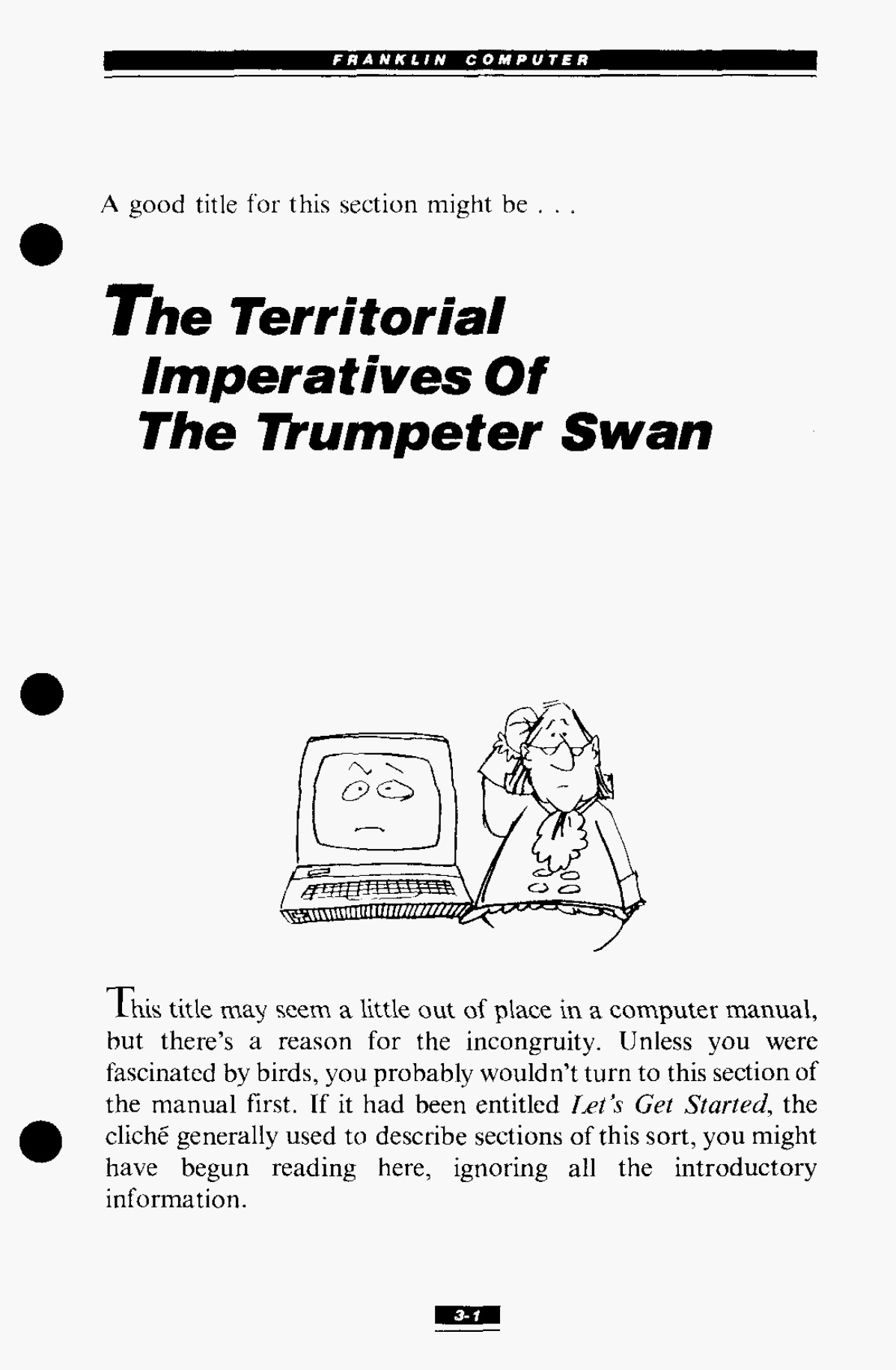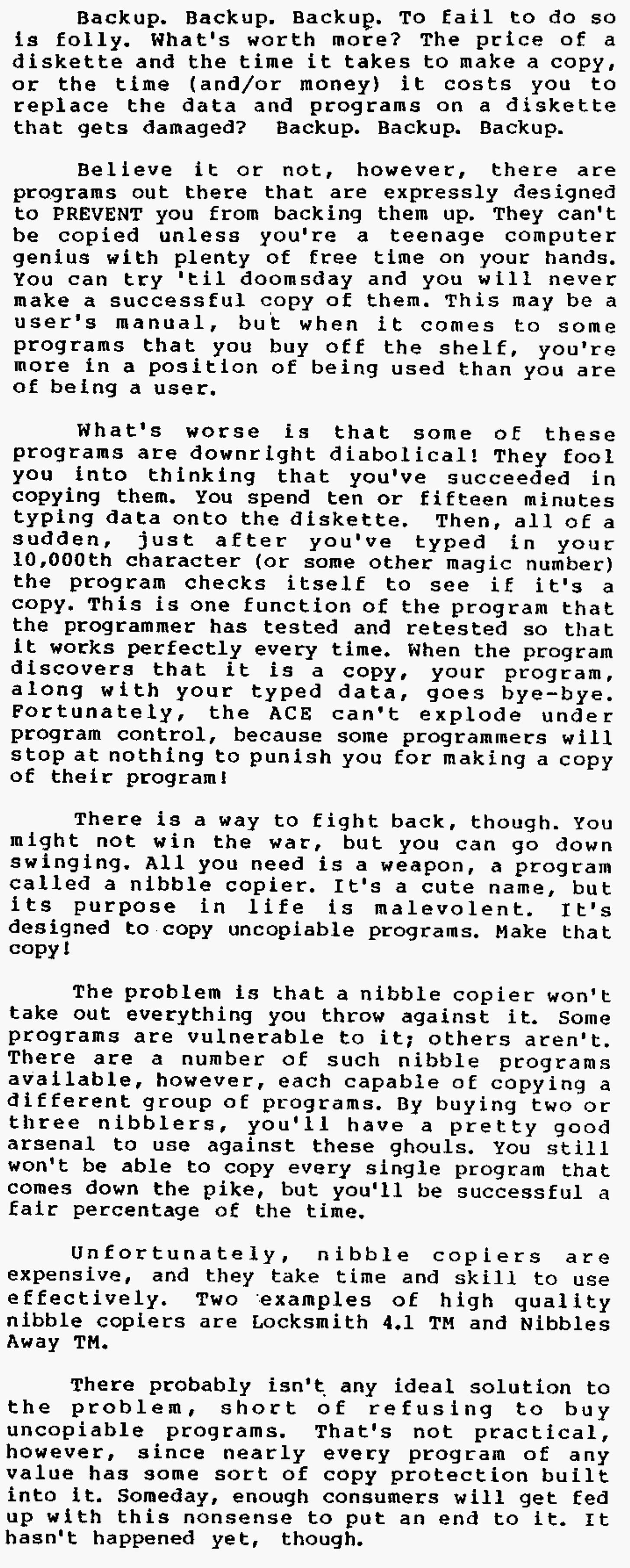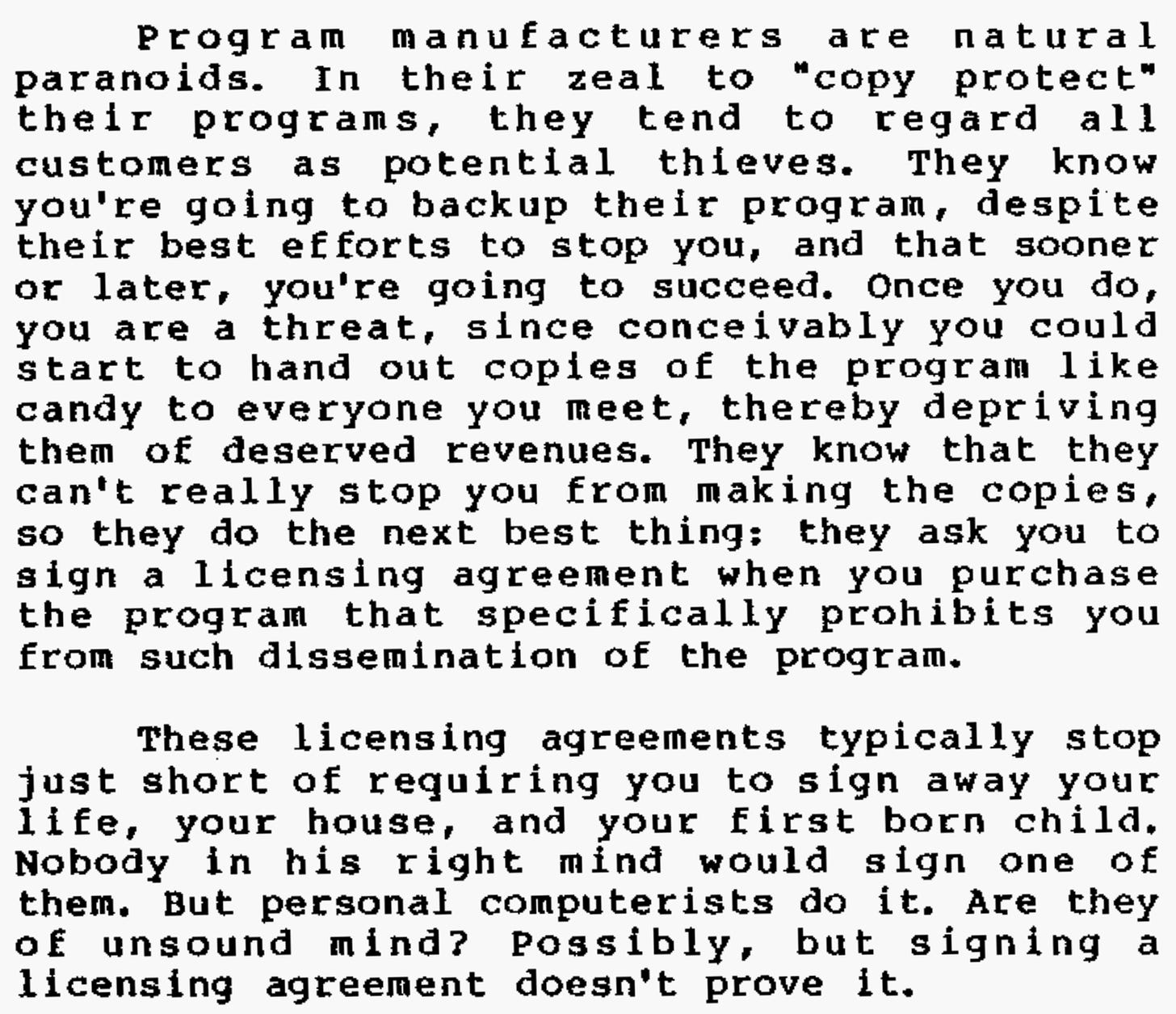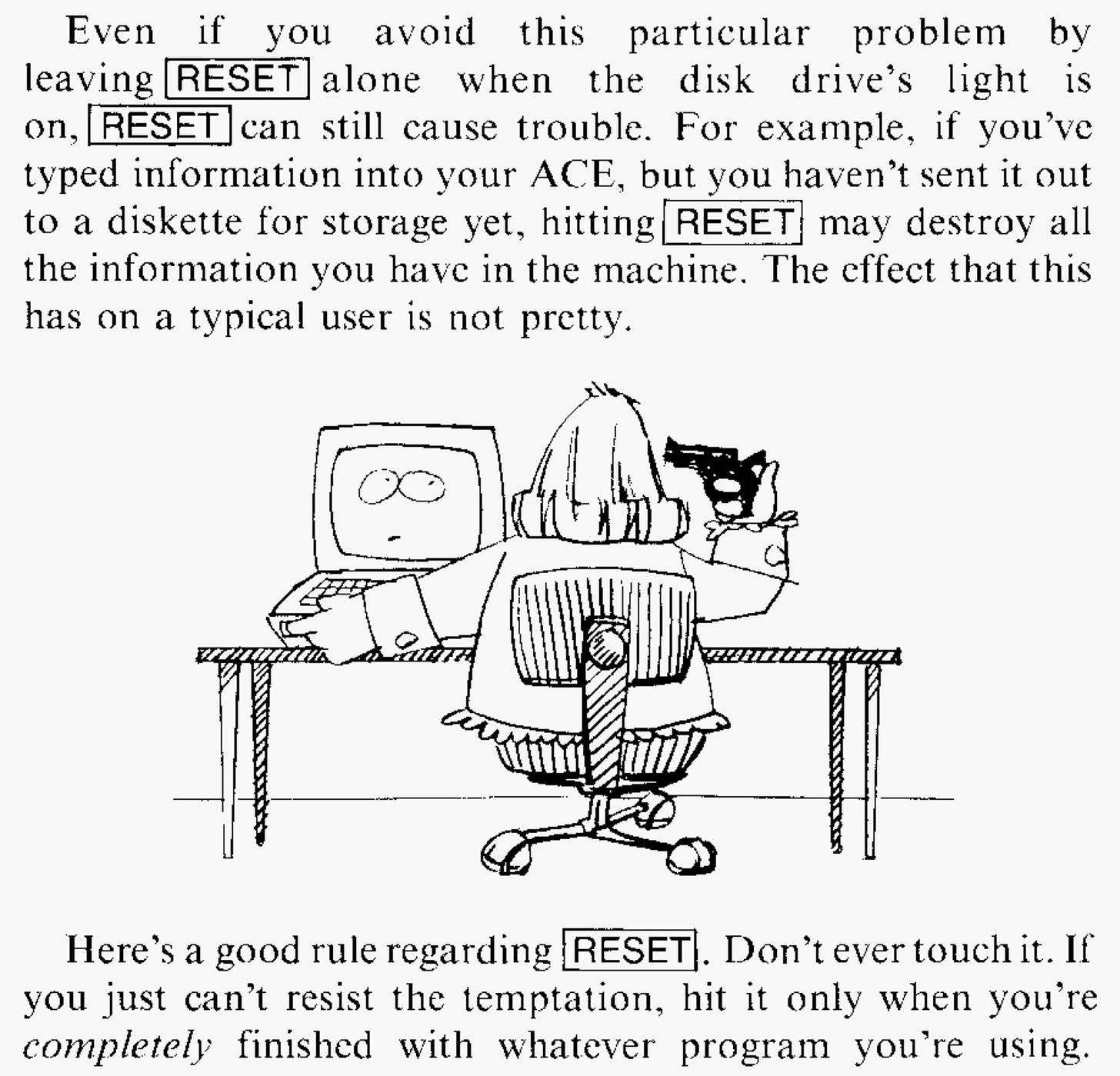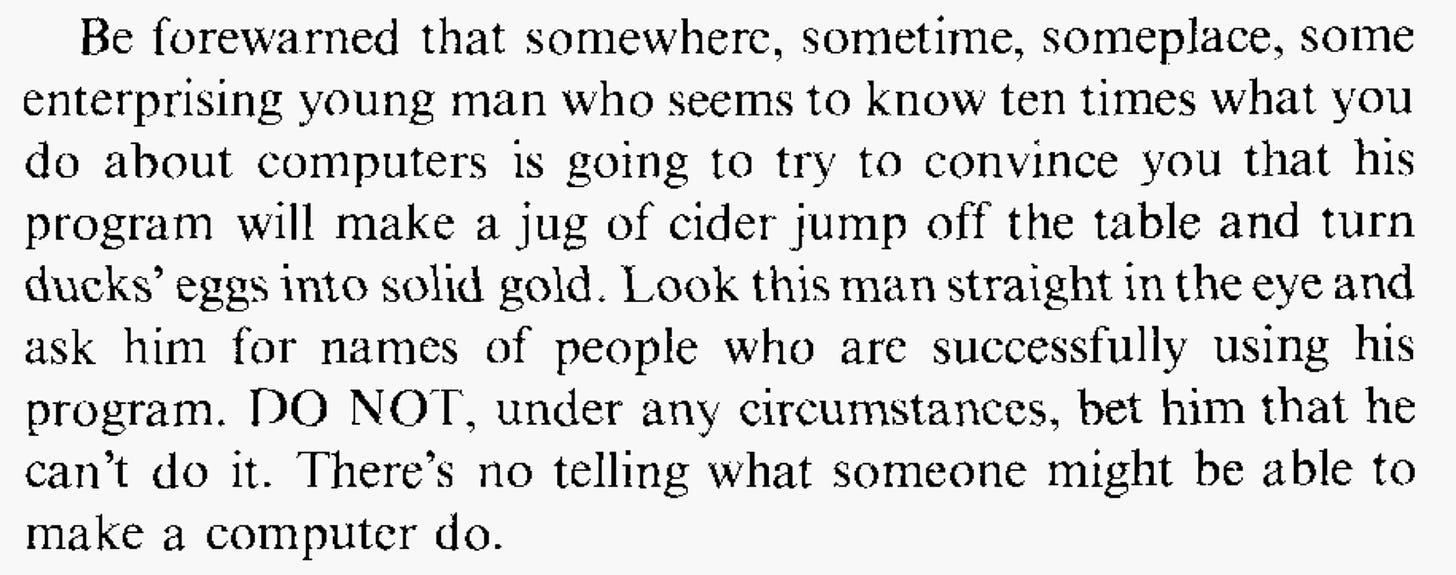In the early 1980s, when the Apple II came out, a company called Franklin made a knock-off version of the same computer. It was a pretty blatant copy, which Apple wasn’t happy about, but the law wasn’t clear yet on whether operating systems could be protected by copyright. Apple eventually sued Franklin, and the court ruled that operating systems could in fact be protected. That put an end to Franklin computers.
But while Franklin’s computers may have been clones, the Franklin manuals were definitely original. They were more than just user-friendly. They were written with a lot of creativity and humor.
The manual for the Franklin Ace 100 begins with about 40 pages of computer basics: What are they and what can they do?
It’s a little late to bring it up now, but a good rule of thumb to keep in mind is that you shouldn’t buy a computer unless you know of at least two things that you can use it for BEFORE you buy it. Using the packing box as a planter for your petunias shouldn’t be one of the two uses.
That sort of thing.
And then, on page 40, there is a chapter called “The Ancestral Territorial Imperatives of the Trumpeter Swan.” That’s a really strange chapter to put in a computer manual. Here’s how the chapter begins:
For the next model, the Franklin Ace 1000, Franklin updated the manual. Instead of being all one monospaced font, it became a lot more readable. Here’s how the same chapter appeared in the manual for the Franklin Ace 1000:
You can see that this manual has friendlier fonts. There are cute cartoons of Benjamin Franklin throughout. But some of the written humor is lost. They no longer call “Let’s Get Started” a “disgustingly cute phrase.” The chapter heading is cushioned with “A good title for this section might be…” This version of the joke loses some of the punch.
But the Ace 1000 manual isn’t just a watered down version of the Ace 100 manual. It has its own jokes, including several humorous glossary entries. For example, in the first chapter of the manual there is a list of things you can do with a computer. One thing it says you can do is “get a list of recommendations for wines to serve with Terrine Maison.” I have no idea what Terrine Maison is. But you’ll find it helpfully defined in the glossary:
The Ace 100 manual includes one section so shocking that I can’t imagine a modern computer company even considering putting it in a manual. In this section, you are advised to circumvent copy protection to make personal backups of programs you lawfully purchased, and it even recommends software to help you do that!
A company that built its flagship product by cloning Apple’s operating system recommends circumventing copy protection. At least they’re consistent.
The manual goes on to describe three categories of crooks in the computer world. The first category is “Them,” the computer salespeople who overhype their products with advertising gimmicks. The second category is “You.” Franklin isn’t actually calling you a crook, but they say that software manufacturers will treat you like one with over-reaching licensing agreements:
The last category of crooks is under the heading “Us”:
I mean, technically I guess that was right, until the court ruling.
You won’t be surprised to hear that most of the “Crooks” section is omitted from the later Ace 1000 manual. But a condensed version still appears in the section about copy protection.
The Ace 1000 manual has a very dark section about the computer’s “reset” button, which was an actual physical button on the machine that they warned you never to press. This is what it says:
There’s a button I’m supposed to never touch? And the accompanying illustration has someone with a gun to his own head as he is about to press the button? Is this some kind of psychological experiment? Now I have to touch it.
Both manuals make contemporary pop culture references, explaining the concept of computer programs by comparing them to TV programs like Hill Street Blues, The Dukes of Hazzard, or Live at the Met with Itzhak Perlman (who the glossary helpfully defines as “a violinist”).
In both manuals, the author tries to explain what kinds of programs are useful and which to stay away from. He states that “the sole purpose of many of these wonders in programming is to separate you from your money.” And then he gives this warning:
I’m pretty sure this is a reference to Damon Runyon, whose stories of 1930s New York hustlers were the basis for the Broadway musical Guys and Dolls. Damon Runyon wrote, “One of these days in your travels, a guy is going to come up to you and show you a nice brand-new deck of cards on which the seal is not yet broken, and this guy is going to offer to bet you that he can make the Jack of Spades jump out of the deck and squirt cider in your ear. But, son, do not bet this man, for as sure as you are standing there, you are going to end up with an earful of cider.”
I first wrote an appreciation of the Franklin manuals back in 2010. And at the time, I found myself wondering what other inside jokes the manual has that I wouldn’t know about. The manuals are uncredited, but I figured out that they were written by a guy named Sal Manetta, who later went on to work for Unisys and Intel. I couldn’t reach him initially, but I did get hold of Bob Applegate, a programmer who had worked at Franklin.
Bob told me:
We hired this tech writer guy who knew nothing about personal computers named Sal Manetta. He was the manager of the Publication group. Sal hired a funky artist [Frank someone-or-other] who did most of the drawings of Ben Franklin in the user manual. Sal was supposed to learn about computers like an average person back then, such as reading magazines, talking to salesmen at stores, etc. Sometimes Dave and I would head over to a local place where I used to work (where Franklin discovered me), would “introduce” ourselves to Sal and give him advice on buying



